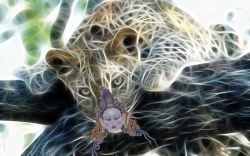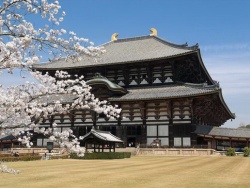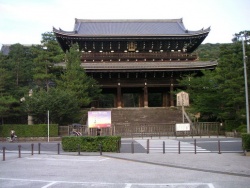Contemporary Mahasiddha of the ‘Seven Lines Prayer’
A liberation story to share… it shows the eternal spirit of Guru Devotion and the unparallelled blessings of Guru Rinpoche. Please enjoy!
Before the year 2000, there was a Mahasiddha in the Namdroling monastery of the Nyingma Palyul tradition established by the lineage holder His Holiness Penor Rinpoche. He mainly recited the ‘Seven Line Prayer to Guru Rinpoche’. This accomplished master had white hair and a hunched back; he went about everywhere on bare feet and his name was Yama Gonpo.
Yama Gonpo was illiterate and had absolutely no idea about writing or reading the scriptures because he had not been taught in school. From his youth until he was old, he had been Penor Rinpoche’s layperson attendant. In his late years, he started wearing monk’s robes and became ordained. He did not know how to recite any scripture or prayer apart from some short mantras, thus, the only practice he was familiar with was the ‘Seven Lines Prayer to Guru Rinpoche’.
About 40 years ago, when the Tibetans fled to India, he followed His Holiness Penor Rinpoche out of Tibet and became Penor Rinpoche’s attendant and guard. It was after much life-threatening dangers that they arrived in India. For his entire life, he was Penor Rinpoche’s unwavering and devoted disciple, serving his Guru like a servant.
After following Penor Rinpoche to South India, because they were beginning to build Namdroling monastery, Yama Gonpo participated in the work of building the monastery. He endured long hours of toilsome labor. For instance, about 40 years ago, there was a large river flowing between the site of the monastery and the neigbouring town of Gusakar. The Indian workers, in order to save time, forced their cows to cross the river but there was no bridge at that time and it was extremely difficult for the cows who were bearing a large load to cross the river. Their Indian owners lashed their whips at these cows, often cutting deeply into the flesh on their backs. Penor Rinpoche decided that, in order to help the cows and everyone involved, it was necessary for him to spend his own money to build a mud bridge over the river although it was extremely expensive by the standards of that time. Yama Gonpo, by a single order of His Holiness, spent three years accompanying the workers to construct this bridge. By night, he slept alone in a grass hut at the construction site as it was his responsibility to watch over the building materials. At that time, his hut was located near the forests and grasslands where many wild animals lurked.
As narrated above, Yama Gonpo’s entire life was that of following the instructions of his Guru, Penor Rinpoche. In his late years, he received the Dzogchen essential pith instructions from Penor Rinpoche personally. From then on, he did not lie down to sleep but always remain sitting, whether during the day or night, becoming an extremely assiduous meditator. His level of realisation was very high and profound, his meditation was liberated and free, he was able to communicate directly with Guru Rinpoche (Padmasambhava) or the Dharma Protectors.
However, externally, he seemed to be just a weak and ordinary old monk…
In his late years, he stayed outside Penor Rinpoche’s special protector hall, in a very simple hut made from mud. This hut was so small that most people could not stand up straight within it. There was an extremely simple altar inside – so simple that the only way to describe it would be ‘unbearably old and broken-down’. It consisted of several pieces of aged, hole-ridden pieces of Buddha images that had turned yellow.
Yama Gonpo personally had few belongings. It consisted of one strand of prayer beads and several pieces of cushions that looked like pieces of rubbish. There was also one small coffee-coloured fat-bellied bottle that had been abandoned by someone. And this was the ‘precious vase’ which Yama Gonpo used to contain his blessed pills mixed with water.
Yama Gonpo had infinite faith in His Holiness Penor Rinpoche and Guru Rinpoche (Padmasambhava) and kept doing his practice without making a display of it. At first, no-one realised that this hunched-back old man was a great practitioner until something happened. Once, when they were setting up the first Buddhist college in the Namdroling monastery (reenacting the tradition of Buddhist studies in the Nyingma tradition for the first time in India), many students were painting the main hall. At that time, Yama Gonpo’s hunched figure appeared in the vicinity despite the fact that he had not been asked to come. Gonpo told the students in a kind and yet serious tone, “Last night, Guru Rinpoche said that the students who are painting the college have an obstacle coming, it would be better to temporarily stop painting tomorrow.
The college students thought that the old Yama Gonpo was mentally unhinged and merely pretended to agree with him with a smile. Then they invited him politely to leave. Before he left, Gonpo said again, “If you are not willing to stop work tomorrow, then please remember to recite the Seven Lines Prayer to Guru Rinpoche or his heart mantra or Tara’s mantra!”
On the second day, one of the students was reciting Tara’s mantra in a half-believing manner while standing with other students on the high structures for painting. In the end, there was an accident. All of a sudden, the high structure collapsed. Everyone was hurt when they fell on the ground. The only person who went unscathed was the student who had been reciting Tara’s mantra. From then on, many people started to ask Yama Gonpo about matters of the future and Gonpo never failed to help them. The future invariably worked out just as he predicted. There was even one situation where someone came to ask about some matter in the future and Yama Gonpo replied him saying, “Please, there is no need for you to ask me about any future problems, because you will soon die in seven days.” When this person heard his prediction, he was very nervous, but he was also half-doubting it. Finally, the prediction came true and he died in seven days.
This matter caused everyone to wake up and many people praised Yama Gonpo for his ability to accurately foresee the future. But somehow, His Holiness Penor Rinpoche was appraised of this matter and became extremely displeased. He simply said one sentence to Yama Gonpo, “Why are you saying so much?” Thereupon, Yama Gonpo kept silent for about one year and refused to reply to anyone’s enquiry.
It was until much later when His Holiness Penor Rinpoche left the monastery to spread the Dharma that the sangha were unable to find anyone to help them when they had particular difficulties that they petitioned Penor Rinpoche to allow Yama Gonpo to help everyone with clearing their doubts and answering their questions with his special abilities. Under His Holiness’s permission, Yama Gonpo started to speak to help the masses.
Before Yama Gonpo answered anyone’s question, he will always meditate for a moment with his eyes open and then he will see the answer without need to recourse to any divination tools or any special preparations. The writer of this article once had the fortune of witnessing the way Yama Gonpo answered questions beside the eight great stupas of Namdroling monastery. It was truly rare and astounding!
Once, Namdroling monastery had a huge case in its hands. An Indian was murdered and his corpse was discovered beside the monastery. One of the monastery’s monk was suspected by the police of being the culprit and apprehended. At that time, Penor Rinpoche was away overseas and could not immediately return to solve this problem. Therefore, in a telephone call, he instructed that the monastery immediately begin to practice the Dharma protector rituals. The next day, Yama Gonpo told everyone, “Last night the Dharma Protector appeared to me and told me, ‘The real murderer has been caught, he is an Indian. Now the Dharma Protector has possessed the murderer and caught hold of his heart and mind, he will be leading the real murderer back to the area of the monastery. As the distance is far, he can only reach the monastery in 3 days.’”
Eventually, after 3 days, the true murderer was really caught. He was an Indian who had performed the killing act in the spur of a moment because of a mere 50 rupees. When the murderer returned to the monastery, his entire being was confused and dazed, and he turned himself in by confessing that the murder was done by him. Of course, he was not spared a beating by the people around him there and then when they heard his confession.
Everyone now knew that Yama Gonpo was an authentic Druptop (realised master). They liked to come by and ask him many questions. But his main reply was, “Recite the Seven Lines Prayer, then there would be no obstacles.” This was often his advice to people.
Although he was so accomplished, he continued his previous style of living, notwithstanding others’ respect and trust in him. He continued staying in his dilapidated hut, his living conditions did not improve, and all day and all night long, he continued to supplicate the Guru Triple Gems. Anyone who saw him felt that he was truly a very diligent practitioner who never had a respite. When anyone offered him money, he would ask the benefactor to offer this money directly to Penor Rinpoche. Even if he took the money to allow the benefactor to accumulate merits, he would still unstintingly offer the whole amount to His Holiness Penor Rinpoche. About 2 or 3 years before he left this world, he often said, “Human life and samsara is simply too much suffering… when the Lord of Refuge Penor Rinpoche has completed the building of the Guru Padmasambhava Hall, I will depart from this world.”
In the remaining days, he continued to behave like his role as an attendant and guard to Penor Rinpoche, he surreptitiously watched over the entire process of building the large hall whether it was a large or minute task. Once, he told some monks who were close to him, “For His Holiness Penor Rinpoche’s project of building the hall to be smooth and successful, countless Dharma Protectors have surrounded the boundaries of the hall in the space and on the ground to prevent any large obstacle from occuring.” Everyday, he would circumambulate the monastery bare-footed at least once. Everyone said that Yama Gonpo had not wavered in the slightest from his past role as the protector and guard, and used all his utmost strength to protect the beneficial activities of his Guru, Penor Rinpoche, in a quiet manner.
When the Guru Padmasambhava Hall in Namdroling monastery was completed. It was said that on one day, during the puja, Yama Gonpo was accidentally pushed to the floor by some young lama. He never recovered from that fall and finally, in the year of 2000, he demonstrated entry into parinirvana. Several days before his parinirvana, his body was thin and weak, and he was lying in bed but his mind was still extremely clear. After his parinirvana, His Holiness indicated that Gonpo was to be buried in the earth and that his body was to be placed in the vicinity of Namdroling, behind the nunnery. Penor Rinpoche also snipped a lock of white hair from Gonpo and kept it for memory sake.
The author (of this article), for fear of forgetting all that has been seen, heard or remembered with the passage of time, decided to pen down everything concerning Yama Gonpo diligently. Afterall, the author has had the karmic affinity of meeting Gonpo several times and had even held his hands while walking together around Namdroling monastery. We stood where would be behind the present elementary school for Namdroling, and enjoyed the scenery of Namdroling monastery from afar in the soft breeze of that afternoon… now that the Venerable one is no longer here, the author, in order to remember him and encourage others to do the practice of Guru Rinpoche, decided to write these notes on 23 August 2007 in Taipei, Taiwan.
(Notes by translator: The names, when translated from Chinese, may not be accurate in spelling. Some very tiny amendments had been made to enable the story to flow better. But nothing factual has been affected. By this merit, may all sentient beings attain enlightenment. )




